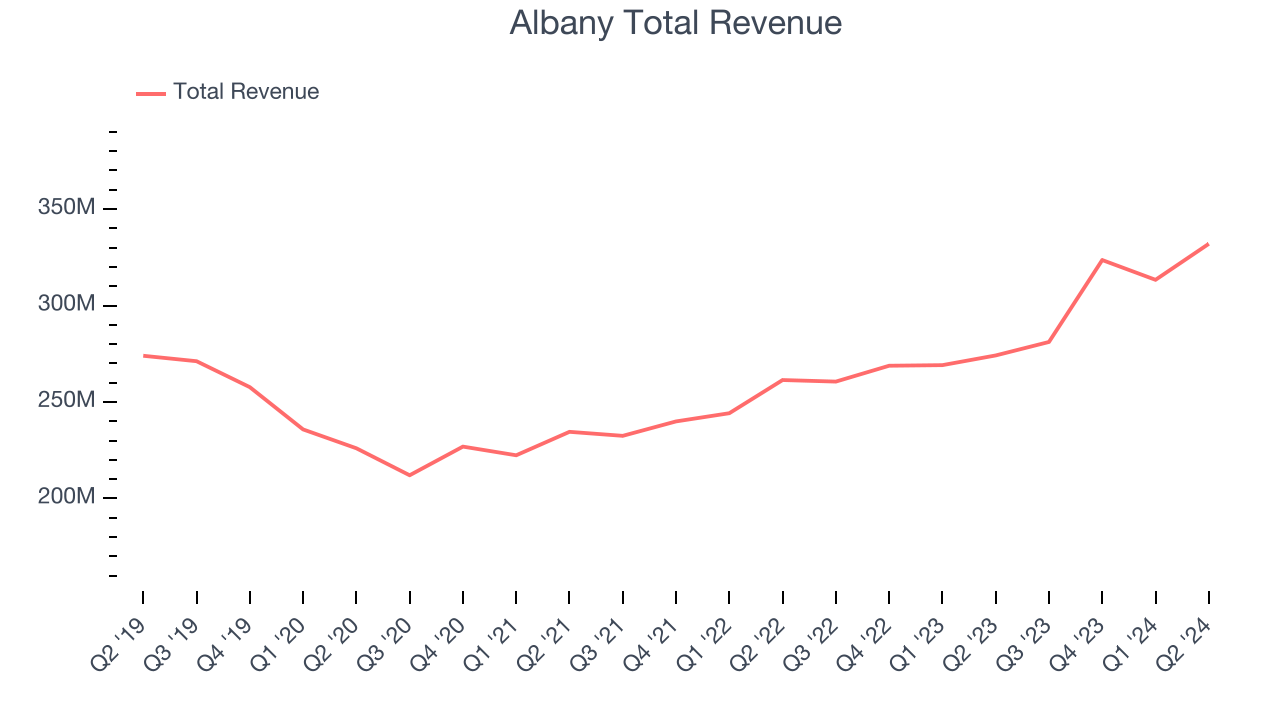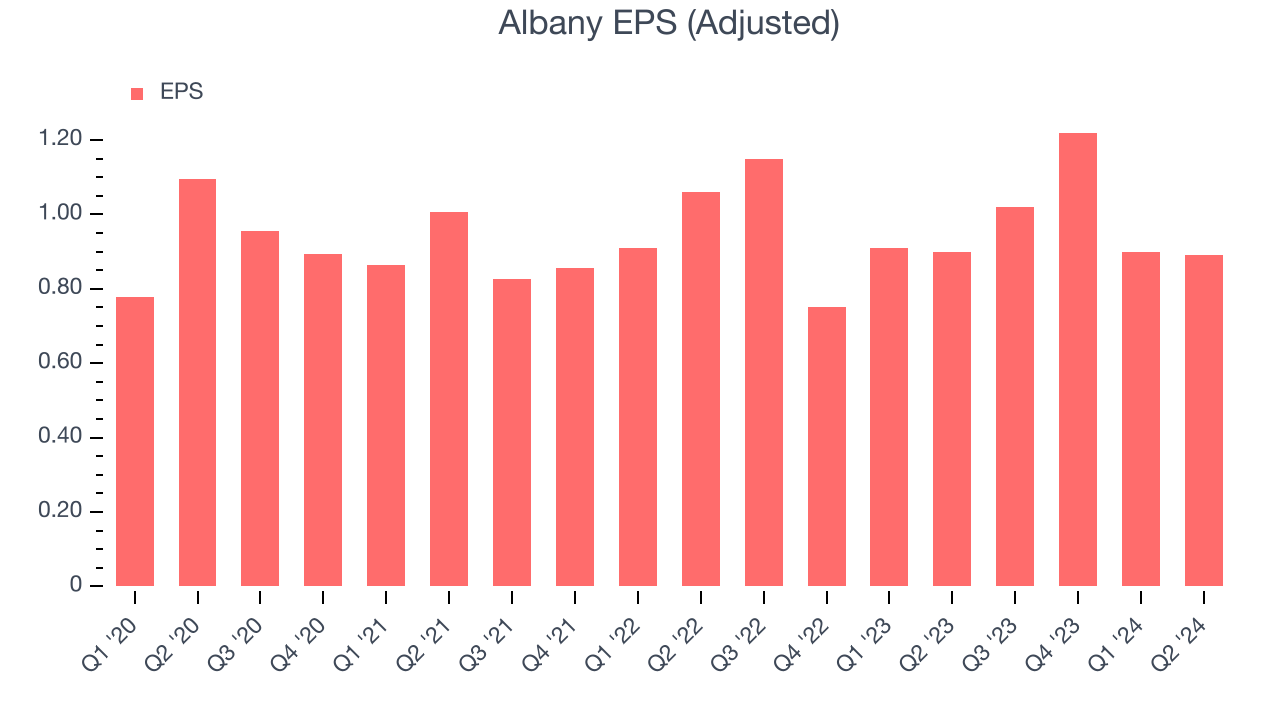Industrial equipment and engineered products manufacturer Albany (NYSE:AIN) reported Q2 CY2024 results topping analysts' expectations, with revenue up 21.1% year on year to $332 million. The company expects the full year's revenue to be around $1.30 billion, in line with analysts' estimates. It made a non-GAAP profit of $0.89 per share, down from its profit of $0.90 per share in the same quarter last year.
Is now the time to buy Albany? Find out by accessing our full research report, it's free.
Albany (AIN) Q2 CY2024 Highlights:
- Revenue: $332 million vs analyst estimates of $316.9 million (4.8% beat)
- EPS (non-GAAP): $0.89 vs analyst expectations of $0.90 (in line)
- The company reconfirmed its revenue guidance for the full year of $1.30 billion at the midpoint
- EPS (non-GAAP) guidance for the full year is $3.80 at the midpoint, missing analyst estimates by 1.1%
- EBITDA guidance for the full year is $275 million at the midpoint, in line with analyst expectations
- Gross Margin (GAAP): 33.9%, down from 37.5% in the same quarter last year
- Adjusted EBITDA Margin: 19%, down from 23.7% in the same quarter last year
- Free Cash Flow of $63.64 million is up from -$17.27 million in the previous quarter
- Market Capitalization: $2.63 billion
"Overall, we had another good quarter as our businesses delivered strong results and are responding well to their industry challenges," said President and CEO, Gunnar Kleveland.
Founded in 1895, Albany (NYSE:AIN) is a global textiles and materials processing company, specializing in machine clothing for paper mills and engineered composite structures for aerospace and other industries.
General Industrial Machinery
Automation that increases efficiency and connected equipment that collects analyzable data have been trending, creating new demand for general industrial machinery companies. Those who innovate and create digitized solutions can spur sales and speed up replacement cycles, but all general industrial machinery companies are still at the whim of economic cycles. Consumer spending and interest rates, for example, can greatly impact the industrial production that drives demand for these companies’ offerings.
Sales Growth
Examining a company's long-term performance can provide clues about its business quality. Any business can put up a good quarter or two, but the best consistently grow over the long haul. Over the last five years, Albany grew its sales at a weak 4.2% compounded annual growth rate. This shows it failed to expand in any major way and is a rough starting point for our analysis. 
We at StockStory place the most emphasis on long-term growth, but within industrials, a half-decade historical view may miss cycles, industry trends, or a company capitalizing on catalysts such as a new contract win or a successful product line. Albany's annualized revenue growth of 13.1% over the last two years is above its five-year trend, suggesting its demand recently accelerated.
We can better understand the company's revenue dynamics by analyzing its most important segments, Machine Clothing and Engineered Composites, which are 58.3% and 41.7% of revenue. Over the last two years, Albany's Machine Clothing revenue (paper manufacturing belts) averaged 9.8% year-on-year growth while its Engineered Composites revenue (aerospace components) averaged 20.2% growth.
This quarter, Albany reported remarkable year-on-year revenue growth of 21.1%, and its $332 million of revenue topped Wall Street estimates by 4.8%. We also like to judge companies based on their projected revenue growth, but not enough Wall Street analysts cover the company for it to have reliable consensus estimates.
Today’s young investors won’t have read the timeless lessons in Gorilla Game: Picking Winners In High Technology because it was written more than 20 years ago when Microsoft and Apple were first establishing their supremacy. But if we apply the same principles, then enterprise software stocks leveraging their own generative AI capabilities may well be the Gorillas of the future. So, in that spirit, we are excited to present our Special Free Report on a profitable, fast-growing enterprise software stock that is already riding the automation wave and looking to catch the generative AI next.
Operating Margin
Operating margin is a key measure of profitability. Think of it as net income–the bottom line–excluding the impact of taxes and interest on debt, which are less connected to business fundamentals.
Albany has been a well-oiled machine over the last five years. It demonstrated elite profitability for an industrials business, boasting an average operating margin of 16.9%. This result isn't surprising as its high gross margin gives it a favorable starting point.
Analyzing the trend in its profitability, Albany's annual operating margin decreased by 6.3 percentage points over the last five years. Even though its margin is still high, shareholders will want to see Albany become more profitable in the future.

This quarter, Albany generated an operating profit margin of 12.9%, down 3.7 percentage points year on year. Since Albany's operating margin decreased more than its gross margin, we can assume the company was recently less efficient because expenses such as sales, marketing, R&D, and administrative overhead increased.
EPS
We track the long-term growth in earnings per share (EPS) for the same reason as long-term revenue growth. Compared to revenue, however, EPS highlights whether a company's growth was profitable.
Albany's full-year EPS dropped 4.5%, or 1.1% annually, over the last four years. We tend to steer our readers away from companies with falling revenue and EPS, where diminishing earnings could imply changing secular trends and preferences. If the tide turns unexpectedly, Albany's low margin of safety could leave its stock price susceptible to large downswings.

Like with revenue, we also analyze EPS over a more recent period because it can give insight into an emerging theme or development for the business. Albany's EPS grew at an unimpressive 5% compounded annual growth rate over the last two years, lower than its 13.1% annualized revenue growth. This tells us the company became less profitable on a per-share basis as it expanded.
We can take a deeper look into Albany's earnings to better understand the drivers of its performance. Albany's operating margin has declined 6.5 percentage points over the last two years. This was the most relevant factor (aside from the revenue impact) behind its lower earnings; taxes and interest expenses can also affect EPS but don't tell us as much about a company's fundamentals.
In Q2, Albany reported EPS at $0.89, down from $0.90 in the same quarter last year. This print was close to analysts' estimates. We also like to analyze expected EPS growth based on Wall Street analysts' consensus projections, but there is insufficient data.
Key Takeaways from Albany's Q2 Results
We were impressed by how significantly Albany blew past analysts' revenue expectations this quarter. We were also glad its Engineered Composites revenue topped Wall Street's estimates. On the other hand, its EPS missed. For the full year outlook, the company reaffirmed revenue guidance. Overall, we think this was a solid quarter. The stock traded up 1.9% to $87.34 immediately after reporting.
Albany may have had a good quarter, but does that mean you should invest right now? When making that decision, it's important to consider its valuation, business qualities, as well as what has happened in the latest quarter. We cover that in our actionable full research report which you can read here, it's free.
